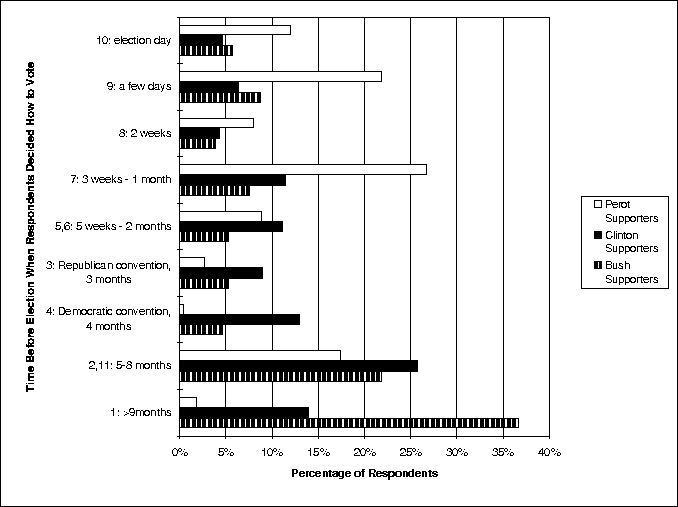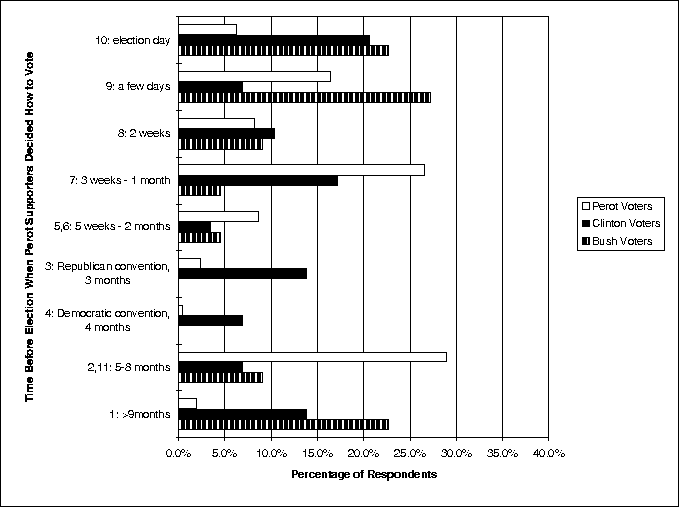The 1992 United States Presidential election provides a familiar context in which to explore declared-strategy voting. The election results themselves reveal little of the voter preference information needed for this analysis; however, data from the 1992 American National Election Study (NES) conducted by the Center for Political Studies at the University of Michigan includes more detailed voter preference information as well as other relevant information.
The NES data set contains data from 2485 respondents. The respondents were asked to rate each of the main candidates in the US Presidential race on a ``feeling thermometer'' scale that ranged from 0 to 100 -- the higher the number, the more favorable the respondent's feeling toward that candidate. This feeling thermometer data can serve as a proxy for utility values. It is also useful for analyzing the extent to which voters behaved strategically in the 1992 Presidential election.
Of the 2485 respondents, 1658 reported voting for one of the three main candidates in the 1992 US Presidential election. Each of these respondent's most preferred candidate was determined by comparing his or her thermometer ratings for all candidates. Data was missing for three respondents, and 358 respondents reported thermometer values that did not indicate a single most preferred candidate (these respondents gave their top rating to two or more candidates). Thermometer data for the remaining 1297 respondents was compared with the actual election vote reported by each respondent. This comparison indicates that 21.5% of Perot supporters (those respondents whose thermometer values indicated they most preferred Perot; they may or may not have actually voted for Perot) voted insincerely, perhaps because they voted strategically. Only 7.7% of Bush supporters and 5.5% of Clinton supporters voted insincerely.
Brams and Merrill performed a similar analysis, but included data from the 131 respondents who gave their top rating to Perot as well as one or both of the other candidates. When this data is included, the percentage of Perot supporters who voted insincerely jumps to 34.5% [20].
The NES data set also contains information about how long before the
election each respondent decided how to vote. Responses are
classified into 12 main categories plus `other', `don't know', and
`not applicable'. Figure ![]() presents a graph of the
responses from the 1398 respondents whose answers to this question
fell into one of the 12 main categories and whose thermometer data
indicated a single preferred candidate. Only 11 of the 12 categories
appear in this set, and two pairs of categories have been combined.
Thus, only nine categories are shown in this graph; the original
category numbers remain as part of the axis labels. The figure
indicates that Perot supporters were more likely than Clinton and Bush
supporters to decide how to vote one month or less prior to the
election. While 74% of Bush supporters and 64% of Clinton
supporters decided for whom to vote more than one month before the
election, only 31% of Perot supporters had made up their minds that
early. This may be due in part to the fact that Perot had temporarily
dropped out of the Presidential race in July and did not re-enter
until a month before the election. However, when we examine the
percentage of voters who decided how to vote in the last few days
before the election or on the day of the election, we see that 34% of
Perot supporters made their decision during that period as compared
with 15% of Bush supporters and 11% of Clinton supporters. This may
be indicative of strategic behavior among Perot supporters.
presents a graph of the
responses from the 1398 respondents whose answers to this question
fell into one of the 12 main categories and whose thermometer data
indicated a single preferred candidate. Only 11 of the 12 categories
appear in this set, and two pairs of categories have been combined.
Thus, only nine categories are shown in this graph; the original
category numbers remain as part of the axis labels. The figure
indicates that Perot supporters were more likely than Clinton and Bush
supporters to decide how to vote one month or less prior to the
election. While 74% of Bush supporters and 64% of Clinton
supporters decided for whom to vote more than one month before the
election, only 31% of Perot supporters had made up their minds that
early. This may be due in part to the fact that Perot had temporarily
dropped out of the Presidential race in July and did not re-enter
until a month before the election. However, when we examine the
percentage of voters who decided how to vote in the last few days
before the election or on the day of the election, we see that 34% of
Perot supporters made their decision during that period as compared
with 15% of Bush supporters and 11% of Clinton supporters. This may
be indicative of strategic behavior among Perot supporters.

Figure: Time before election when voters decided how to vote
Figure ![]() provides further evidence of strategic
behavior. This graph includes only the data from the 258 Perot
supporters whose answers to the above question fell into one of the 12
main categories. Fifty percent of the Perot supporters who ended up
voting for Bush made their decision within the last few days before
the election or on election day. Only 28% of those who ended up
voting for Clinton and 23% of those who ended up voting for Perot
made their decision during that period. Given that the polls
published during the week of the election [51] predicted
that Clinton would win with over 42% of the popular vote and Perot
would come in third with under 16% of the popular vote, the voters
who had the most to gain by voting strategically were the Perot
supporters who preferred Bush to Clinton. Had sufficient numbers of
these voters voted strategically without Perot supporters who
preferred Clinton to Bush doing likewise, they might have secured a
victory for their second choice candidate.
provides further evidence of strategic
behavior. This graph includes only the data from the 258 Perot
supporters whose answers to the above question fell into one of the 12
main categories. Fifty percent of the Perot supporters who ended up
voting for Bush made their decision within the last few days before
the election or on election day. Only 28% of those who ended up
voting for Clinton and 23% of those who ended up voting for Perot
made their decision during that period. Given that the polls
published during the week of the election [51] predicted
that Clinton would win with over 42% of the popular vote and Perot
would come in third with under 16% of the popular vote, the voters
who had the most to gain by voting strategically were the Perot
supporters who preferred Bush to Clinton. Had sufficient numbers of
these voters voted strategically without Perot supporters who
preferred Clinton to Bush doing likewise, they might have secured a
victory for their second choice candidate.

Figure: Time before election when Perot supporters decided how to vote
It is also useful to examine the results of some of the Gallup Polls conducted prior to the 1992 Presidential election. A survey conducted during 13-15 October (less than 3 weeks before the election) asked voters whether there was any chance they would vote for a candidate other than the one they said they planned to vote for. Seventy-eight percent of Perot supporters said they might vote for another candidate as opposed to 43% of Bush supporters and 37% of Clinton supporters. When Perot supporters were asked what they would do if, in November, it looked like Perot could not win, 36% said they would vote for Perot anyway, while 26% said they would switch to Bush, 30% said they would switch to Clinton, and 8% expressed no opinion [51]. These results also suggest strategic behavior.
We used the NES thermometer data to simulate the 1992 US Presidential election under declared-strategy voting. Although DSV would not have changed the election winner, it would have likely revealed far more information about voter preferences than was revealed through plurality voting. In the actual 1992 election, Bush received 37.7% of the popular vote, Clinton received 43.3% of the popular vote, and Perot received 19.0% of the popular vote. The NES data indicates a slightly higher popular vote percentage for Clinton (post election surveys often show more support for the winner than election results indicate). Our DSV simulations all resulted in a much higher vote count for Clinton and a much lower vote count for Perot.
Our DSV simulations used the NES thermometer data from all 2171 respondents for which it was available, regardless of whether they reported voting. In order to study the effect of indifference we conducted our simulations with the complete thermometer data set and again with data from only the 1820 respondents who indicated a single first-choice candidate. Ballot-by-ballot simulations conducted with the 2171 respondent data set had an outcome stability of 97.1% while those conducted with the 1820 respondent data set had an outcome stability of 99.0%. The results of the actual election, polls, and our simulations are summarized in the table below.
